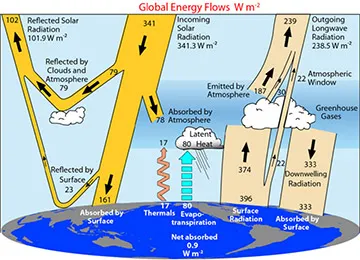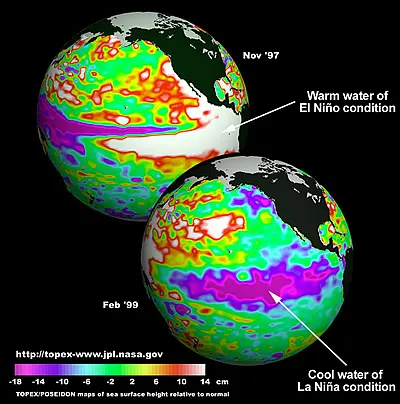Atmospheric Science Literacy Framework
In November 2007, UCAR and CIRES hosted a workshop to develop a consensus framework for enhancing our nation’s atmospheric science and climate literacy. The workshop was sponsored by the NSF and NOAA, and incorporated input from 60 participants including representatives from NAGT, NESTA, AMS and AGU. The workshop was held at UCAR’s Center Green campus in Boulder, Colorado.
This page serves as an archive of the outcomes of that workshop. The alignment to specific science education standards presented in the Atmospheric Science Literacy Framework are less germane since the release of the Next Generation Science Standards (NGSS) in 2013. However, the Essential Principles and Fundamental Concepts presented in the Framework remain a good overview of key concepts in the atmospheric sciences.
Essential Principles and Fundamental Concepts of Atmospheric Science

People who are literate in atmospheric science understand the "big ideas" of the relevant scientific knowledge. Armed with this understanding, they will have the basis to communicate about the Earth's atmosphere in a meaningful way, and be equipped to make informed and responsible decisions about activities that impact the Earth's atmosphere. This framework for Atmospheric Science Literacy provides guidance to educators and the public on these big ideas. We have chosen to structure the framework with Essential Principles (EPs) at the highest level, on which more detailed information depends. Subordinate and more specific Fundamental Concepts (FCs) offer foundational knowledge which is needed to fully understand the Essential Principles.
The Atmospheric Science Literacy Framework is a component of a larger effort to develop a comprehensive literacy framework for the entire Earth System. Several other related frameworks have already been completed, including frameworks for Climate Literacy, Earth Science Literacy, Ocean Literacy and Energy Literacy. We expect that this and the other frameworks mentioned above will be incorporated into a larger Earth System literacy framework in future work.
Essential Principle 1: Earth has a thin atmosphere that sustains life.

Fundamental Concept 1.1
Earth's atmosphere is a mixture of gases with small, but important, quantities of liquid and solid particles.
Fundamental Concept 1.2
The atmosphere has mass, is bound to Earth by gravity, and exerts pressure which is greater near Earth's surface and decreases with altitude.
Fundamental Concept 1.3
The atmosphere, which is very thin relative to Earth's radius, varies vertically in layers which differ in composition, density, and temperature. The lowest 8-16 km of the atmosphere - the troposphere - contains most of Earth's weather systems.
Fundamental Concept 1.4
Earth's atmosphere sustains and protects living things. Its composition has changed over time, as it has been influenced by life and by geological and geochemical processes. Through photosynthesis, plants produce the oxygen in the atmosphere that makes life possible.
Fundamental Concept 1.5
Other bodies in the Solar System also have atmospheres. Their composition and motions vary considerably from those of Earth's atmosphere due to planetary size, place in the Solar System, speed of rotation, and other planetary processes.
Essential Principle 2: Energy from the Sun drives atmospheric processes.

Fundamental Concept 2.1
Earth receives energy in the form of electromagnetic radiation from the Sun. Some of this solar energy is absorbed by the atmosphere, some is scattered back to space, and some is transmitted through the atmosphere to be absorbed or reflected by Earth's surface. The solar energy reflected by Earth's surface is absorbed, scattered, or transmitted by the atmosphere.
Fundamental Concept 2.2
Energy from the Sun is transformed into other forms of energy in the Earth System. In the atmosphere these other forms include thermal energy of gas molecules, the kinetic energy of wind, and the latent heat of evaporation stored in water vapor.
Fundamental Concept 2.3
On human time scales, the energy emitted by the Sun is nearly constant, varying only very slightly due to solar activity. The amount of solar energy received at a point on Earth's surface varies due to Earth's spherical shape, its daily rotation about its tilted axis, its annual revolution around the Sun, and the slight elliptical shape of Earth's orbit, leading to important cycles such as day and night, and the seasons. In addition, cloud cover and aerosols can reduce the amount of solar energy that reaches Earth's surface.
Fundamental Concept 2.4
Solar energy drives many chemical, biological, and physical processes that affect Earth's atmosphere. These include processes such as photosynthesis, evaporation of liquid water to produce water vapor, formation of smog, and the formation and destruction of ozone.
Fundamental Concept 2.5
Earth also emits energy in the form of electromagnetic radiation. Almost all of the energy emitted comes from the solar energy absorbed by Earth's surface. This terrestrial energy is absorbed by atmospheric trace gases, such as water vapor, carbon dioxide, and other gases in Earth's atmosphere. It may be reemitted from the atmosphere, either to space, where it is lost to the Earth System, or back to Earth, where it is again absorbed, producing a "Greenhouse Effect". This natural Greenhouse Effect is necessary for life to exist on Earth.
Essential Principle 3: Atmospheric circulation transports matter and energy.

This satellite image shows Hurricane Dorian (2019) at its peak. Dorian is the most destructive natural disaster in recorded history to hit the Bahamas.
NOAA
Fundamental Concept 3.1
Horizontal and vertical energy imbalances in the Earth System produced by unequal heating of Earth's surface create movement in the atmosphere and the ocean.
Fundamental Concept 3.2
Energy is exchanged within the atmosphere, as well as gained and lost across its interface with land and ocean through physical, geological, and biological processes organized in Earth System cycles (e.g. the water cycle). These exchanges help drive atmospheric circulations.
Fundamental Concept 3.3
Patterns of circulation in Earth's atmosphere can be observed at many different spatial scales from global to local. Temperature differences, the rotation of Earth on its axis, and the configuration of the continents and oceans establish the large-scale atmospheric circulation.
Fundamental Concept 3.4
Atmospheric transport of water affects the formation and development of clouds, precipitation, and weather systems, which are all important components of the global water cycle.
Fundamental Concept 3.5
Atmospheric circulations distribute matter and energy globally and establish weather and climate patterns.
Essential Principle 4: Earth's atmosphere changes over time and space, giving rise to weather and climate.

Fundamental Concept 4.1
Weather is the state of Earth's atmosphere at a particular place and time. The climate of a particular place encompasses the long term range of weather conditions at that place. Earth's global climate is determined by the energy received from the Sun and is regulated by atmospheric composition and by atmospheric and oceanic circulation.
Fundamental Concept 4.2
Weather changes over time periods ranging from seconds to weeks. Climate changes over intervals ranging from years to millennia. Earth's history has been marked by gradual variations in global climate caused by long-term cyclic variations in Earth's orbit and axial tilt, and modulated by changes over geologic time in the sizes and distribution of the continents. These gradual variations have been punctuated by relatively abrupt climatic shifts caused by volcanic eruptions and sudden redistributions of mass and energy in the Earth System.
Fundamental Concept 4.3
Both weather and climate vary by region based on latitude, altitude, land use, proximity to physical features such as the ocean and mountains, and ocean currents.
Fundamental Concept 4.4
Weather phenomena are important to human society. As evidenced in art, literature, and human culture over time, some atmospheric phenomena are beautiful, inspiring the human spirit. Severe weather, such as thunderstorms, tornadoes, and hurricanes, can bring rapid, dramatic changes to ecosystems and to individuals, property, and infrastructure.
Essential Principle 5: Earth's atmosphere continuously interacts with the other components of the Earth System.

The red and white color of the eastern tropical Pacific in the upper image (from Nov. 1997) indicates a higher than normal ocean level due to the piling up of warm ocean water during El Niño. The lower image (Feb 1999) shows the ocean level during La Niña when there is cool water from upwelling in the eastern tropical Pacific. Data is from TOPEX/Poseidon and Jason-1 and shows the height of the ocean surface.
NASA JPL
Fundamental Concept 5.1
Earth's atmosphere exchanges energy and matter within the Earth System through physical processes such as photosynthesis, the water cycle, biogeochemical cycles, the rock cycle, and ocean currents.
Fundamental Concept 5.2
Interactions and feedbacks among the components of the Earth System can produce short-term oscillations (such as El Niño and La Niña conditions in the Pacific Ocean), long-term changes in the state of the system (such as global warming), and abrupt, unexpected events (such as sudden release of methane from permafrost).
Fundamental Concept 5.3
Earth's atmosphere plays an important role in biogeochemical cycles in the Earth System. For example, the atmosphere is a reservoir of carbon in the Earth System, storing carbon released from natural processes and fossil fuel burning. Plants extract carbon from the atmosphere through photosynthesis.
Fundamental Concept 5.4
As a result of the long time-scales inherent in some Earth System processes, the impacts of some events may be felt only slowly throughout the Earth System and may continue to be influential long after the original event has changes. For example, because of the long time-scale of deep ocean circulation, an abrupt regional change in ocean salinity may take centuries to be reflected in the global circulation of the ocean.
Essential Principle 6: We seek to understand the past, present, and future behavior of Earth's atmosphere through scientific observation and reasoning.

Fundamental Concept 6.1
Our understanding of Earth's atmosphere comes from analysis, interpretation, and synthesis of accurate and purposeful observations of the atmosphere, ocean, biosphere, land surface, and Polar Regions.
Fundamental Concept 6.2
Data about Earth's atmosphere are gathered by direct (in situ) measurement of temperature, precipitation, wind, pressure, and other variables, as well as by indirect (remote sensing) measurements taken at a distance using ground-based, satellite, and airborne measurements.
Fundamental Concept 6.3
Our understanding of Earth's atmosphere allows scientists to develop numerical (computer) models that can be used to simulate Earth's weather and climate. Such models are fundamental to modern weather analysis and forecasting and are essential to scientists' efforts to understand Earth's past climate and predict future climate.
Fundamental Concept 6.4
To generate predictions, numerical models must begin with observations of Earth's atmosphere and the planet's land and ocean surfaces. These data are used to provide starting conditions for models that are as complete as possible.
Fundamental Concept 6.5
Inaccuracies and the imprecision inherent in instruments, mathematical representations of physical processes, model resolution, and discrete numerical calculations limit the accuracy of the resulting simulations and predictions. Models improve with technological and theoretical advances, which improve data quality and quantity and our ability to represent physical processes. The chaotic nature and inherent complexity of some natural processes ultimately limits how far in advance atmospheric phenomena can be predicted, forcing the use of statistical projections.
Essential Principle 7: Earth's atmosphere and humans are inextricably linked.

Fundamental Concept 7.1
Most living organisms on Earth are dependent on Earth's atmosphere and its processes for survival. We require oxygen for breathing; rely on ozone in the stratosphere to protect us from harmful radiation from the Sun; depend on prevailing wind patterns to drive ocean upwelling and so supply food; rely on wind to power turbines, sails, and ventilators; and need rain for drinking water.
Fundamental Concept 7.2
Living organisms can and do change the composition of Earth's atmosphere and its processes. Many human activities, such as farming, forestry, building of cities, and burning of fossil fuels, alter atmosphere composition and thereby impact the functioning of ecosystems, human health, and climate on local, regional, and global scales.
Fundamental Concept 7.3
Human cultures around the world have adapted differently over hundreds to thousands of years to their unique local and regional weather and climate. Societies have different levels of vulnerability to rapidly changing weather and climate conditions. Severe weather can have major impact on individuals as well as society. Global and regional climate change may bring major changes to vulnerable cultures.
Fundamental Concept 7.4
Weather forecasts and predictions of future climate assist us in implementing mitigation strategies and adaptation to new climatic conditions.
Fundamental Concept 7.5
Citizens need to become educated about Earth's atmosphere to make informed decisions on issues at local, regional, and global scales.
© 2007 UCAR